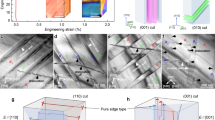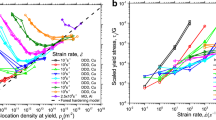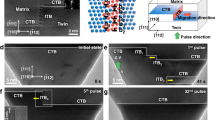Abstract
Dislocation motion, an important mechanism underlying crystal plasticity, is critical for the hardening, processing and application of a wide range of structural and functional materials. For decades, the movement of dislocations has been widely observed in crystalline solids under mechanical loading. However, the goal of manipulating dislocation motion via a non-mechanical field alone remains elusive. Here we present real-time observations of dislocation motion controlled solely by using an external electric field in single-crystalline zinc sulfide—the dislocations can move back and forth depending on the direction of the electric field. We reveal the non-stoichiometric nature of dislocation cores and determine their charge characteristics. Both negatively and positively charged dislocations are directly resolved, and their glide barriers decrease under an electric field, explaining the experimental observations. This study provides direct evidence of dislocation dynamics controlled by a non-mechanical stimulus and opens up the possibility of modulating dislocation-related properties.
This is a preview of subscription content, access via your institution
Access options
Access Nature and 54 other Nature Portfolio journals
Get Nature+, our best-value online-access subscription
$29.99 / 30 days
cancel any time
Subscribe to this journal
Receive 12 print issues and online access
$259.00 per year
only $21.58 per issue
Buy this article
- Purchase on Springer Link
- Instant access to full article PDF
Prices may be subject to local taxes which are calculated during checkout




Similar content being viewed by others
Data availability
The data that support the findings of this study are available within the article and the supplementary information. Any other relevant data are also available upon reasonable request from the corresponding authors.
Code availability
Additional data including the codes are available from the corresponding authors upon reasonable request.
References
Taylor, G. I. The mechanism of plastic deformation of crystals. Part I.—Theoretical. Proc. Roy. Soc. A 145, 362–387 (1934).
Polanyi, M. Über eine art gitterstörung, die einen kristall plastisch machen könnte. Z. Phys. 89, 660–664 (1934).
Orowan, E. Plasticity of crystals. Z. Phys. 89, 605–659. (1934).
Weiss, I. & Semiatin, S. Thermomechanical processing of beta titanium alloys—an overview. Mater. Sci. Eng. A 243, 46–65 (1998).
Courtney, T. H. Mechanical Behavior of Materials (Waveland Press, 2005).
Shi, X. et al. Room-temperature ductile inorganic semiconductor. Nat. Mater. 17, 421–426 (2018).
Sugiura, L. Dislocation motion in GaN light-emitting devices and its effect on device lifetime. J. Appl. Phys. 81, 1633–1638 (1997).
Clark, J. N. et al. Three-dimensional imaging of dislocation propagation during crystal growth and dissolution. Nat. Mater. 14, 780–784 (2015).
Sun, X. et al. Dislocation-induced stop-and-go kinetics of interfacial transformations. Nature 607, 708–713 (2022).
Reddy, K. M. et al. Dislocation-mediated shear amorphization in boron carbide. Sci. Adv. 7, eabc6714 (2021).
He, Y. et al. In situ observation of shear-driven amorphization in silicon crystals. Nat. Nanotechnol. 11, 866–871 (2016).
Anderson P.M., Hirth J.P., Lothe J. Theory of dislocations (Cambridge Univ. Press, 2017).
Gilman, J. Dislocation mobility in crystals. J. Appl. Phys. 36, 3195–3206 (1965).
Kondo, S., Shibata, N., Mitsuma, T., Tochigi, E. & Ikuhara, Y. Dynamic observations of dislocation behavior in SrTiO3 by in situ nanoindentation in a transmission electron microscope. Appl. Phys. Lett. 100, 181906 (2012).
Dresselhaus-Marais, L. E. et al. In situ visualization of long-range defect interactions at the edge of melting. Sci. Adv. 7, eabe8311 (2021).
Conrad, H. Thermally activated plastic flow of metals and ceramics with an electric field or current. Mater. Sci. Eng. A 322, 100–107 (2002).
Zhao, S. et al. Defect reconfiguration in a Ti–Al alloy via electroplasticity. Nat. Mater. 20, 468–472 (2021).
Li, X., Turner, J., Bustillo, K. & Minor, A. M. In situ transmission electron microscopy investigation of electroplasticity in single crystal nickel. Acta Mater. 223, 117461 (2022).
Troitskii, O. & Likhtman, V. Anisotropy of the effect of electronic and α-irradiation on the process of deformation of zinc single crystals in the brittle state. Dokl. Akad. Nauk SSSR 1963, 332–334 (1963).
Westbrook, J. & Gilman, J. An electromechanical effect in semiconductors. J. Appl. Phys. 33, 2360–2369 (1962).
Osip’yan, Y. A., Petrenko, V. F., Zaretskiĭ, A. V. & Whitworth, R. W. Properties of II–VI semiconductors associated with moving dislocations. Adv. Phys. 35, 115–188 (1986).
Koubaiti, S., Couderc, J., Levade, C. & Vanderschaeve, G. Photoplastic effect and Vickers microhardness in III–V and II–VI semiconductor compounds. Mater. Sci. Eng. A 234, 865–868 (1997).
Oshima, Y., Nakamura, A. & Matsunaga, K. Extraordinary plasticity of an inorganic semiconductor in darkness. Science 360, 772–774 (2018).
Dong, J. et al. Giant and controllable photoplasticity and photoelasticity in compound semiconductors. Phys. Rev. Lett. 129, 065501 (2022).
Conrad, H., Sprecher, A., Cao, W. & Lu, X. Electroplasticity—the effect of electricity on the mechanical properties of metals. JOM 42, 28–33 (1990).
Lahiri, A., Shanthraj, P. & Roters, F. Understanding the mechanisms of electroplasticity from a crystal plasticity perspective. Model. Simul. Mater. Sci. Eng. 27, 085006 (2019).
Li, X. et al. Revealing the pulse-induced electroplasticity by decoupling electron wind force. Nat. Commun. 13, 6503 (2022).
Mendel, E. & Weinig, S. Generation of dislocations by an electric field in MgO. J. Appl. Phys. 31, 738–739 (1960).
Caffyn, J., Goodfellow, T. & Hamdani, A. The movement of dislocations in an electric field in sodium chloride. Mater. Res. Bull. 2, 1067–1073 (1967).
Colombo, L., Kataoka, T. & Li, J. Movement of edge dislocations in KCl by large electric fields. Philos. Mag. A 46, 211–215 (1982).
Yu, Q. et al. Strong crystal size effect on deformation twinning. Nature 463, 335–338 (2010).
Zheng, H., Meng, Y. S. & Zhu, Y. Frontiers of in situ electron microscopy. MRS Bull. 40, 12–18 (2015).
Li, M. et al. Electric-field control of the nucleation and motion of isolated three-fold polar vertices. Nat. Commun. 13, 6340 (2022).
Xie, D. et al. Hydrogenated vacancies lock dislocations in aluminium. Nat. Commun. 7, 13341 (2016).
Yu, Q., Legros, M. & Minor, A. M. In situ TEM nanomechanics. MRS Bull. 40, 62–70 (2015).
Nam, S.-W. et al. Electrical wind force–driven and dislocation-templated amorphization in phase-change nanowires. Science 336, 1561–1566 (2012).
Warner, J. H. et al. Dislocation-driven deformations in graphene. Science 337, 209–212 (2012).
Callahan, P. G., Haidet, B. B., Jung, D., Seward, G. G. E. & Mukherjee, K. Direct observation of recombination-enhanced dislocation glide in heteroepitaxial GaAs on silicon. Phys. Rev. Mater. 2, 081601 (2018).
Faress, A., Levade, C. & Vanderschaeve, G. TEM in situ investigation of dislocation mobility in II-VI semiconductor compound ZnS cathodoplastic effect and the Peierls mechanism. Philos. Mag. A 68, 97–112 (1993).
Krivanek, O. L. et al. Atom-by-atom structural and chemical analysis by annular dark-field electron microscopy. Nature 464, 571–574 (2010).
Hirsch, P. The structure and electrical properties of dislocations in semiconductors. J. Microsc. 118, 3–12 (1980).
Elsner, J. et al. Deep acceptors trapped at threading-edge dislocations in GaN. Phys. Rev. B 58, 12571–12574 (1998).
Henkelman, G. & Jónsson, H. Improved tangent estimate in the nudged elastic band method for finding minimum energy paths and saddle points. J. Chem. Phys. 113, 9978–9985 (2000).
Henkelman, G., Uberuaga, B. P. & Jónsson, H. A climbing image nudged elastic band method for finding saddle points and minimum energy paths. J. Chem. Phys. 113, 9901–9904 (2000).
Miranda, C. R., Nunes, R. W. & Antonelli, A. Temperature effects on dislocation core energies in silicon and germanium. Phys. Rev. B 67, 235201 (2003).
George, A. J. M. S. & A, E. Plastic deformation of semiconductors: some recent advances and persistent challenges. Mater. Sci. Eng. A 233, 88–102 (1997).
Li, J. C. Charged dislocations and plasto-electric effect in ionic crystals. Mater. Sci. Eng. A 287, 265–271 (2000).
Shibata, N. et al. Nonstoichiometric dislocation cores in α-alumina. Science 316, 82–85 (2007).
Whitworth, R. W. Charged dislocations in ionic crystals. Adv. Phys. 24, 203–304 (1975).
Zhou, X. W., Foster, M. E., Yang, P. & Doty, F. P. Molecular dynamics simulations of dislocations in TlBr crystals under an electrical field. MRS Adv. 1, 2459–2464 (2016).
Petrenko, V. F. & Whitworth, R. W. Charged dislocations and the plastic deformation of II-VI compounds. Philos. Mag. A 41, 681–699 (2006).
Yonenaga, I. Hardness, yield strength, and dislocation velocity in elemental and compound semiconductors. Mater. Trans. 46, 1979–1985 (2005).
Qin, L. C., Li, D. X. & Kuo, K. H. An HREM study of the defects in ZnS. Philos. Mag. A 53, 543–555 (1986).
Yonenaga, I. Atomic structures and dynamic properties of dislocations in semiconductors: current progress and stagnation. Semicond. Sci. Technol. 35, 043001 (2020).
Gao, P. et al. Picometer-scale atom position analysis in annular bright-field STEM imaging. Ultramicroscopy 184, 177–187 (2018).
Kresse, G. & Furthmüller, J. Efficiency of ab-initio total energy calculations for metals and semiconductors using a plane-wave basis set. Comput. Mater. Sci. 6, 15–50 (1996).
Kresse, G. & Furthmüller, J. Efficient iterative schemes for ab initio total-energy calculations using a plane-wave basis set. Phys. Rev. B 54, 11169–11186 (1996).
Kresse, G. & Hafner, J. Ab initio molecular dynamics for liquid metals. Phys. Rev. B 47, 558–561 (1993).
Kresse, G. & Joubert, D. From ultrasoft pseudopotentials to the projector augmented-wave method. Phys. Rev. B 59, 1758–1775 (1999).
Blöchl, P. E., Jepsen, O. & Andersen, O. K. Improved tetrahedron method for Brillouin-zone integrations. Phys. Rev. B 49, 16223–16233 (1994).
Justo, J. F., Bulatov, V. V. & Yip, S. Dislocation core reconstruction and its effect on dislocation mobility in silicon. J. Appl. Phys. 86, 4249–4257 (1999).
Huang, L. & Wang, S. A theoretical investigation of the glide dislocations in the sphalerite ZnS. J. Appl. Phys. 124, 175702 (2018).
Matsunaga, K. et al. Carrier-trapping induced reconstruction of partial-dislocation cores responsible for light-illumination controlled plasticity in an inorganic semiconductor. Acta Mater. 195, 645–653 (2020).
Henkelman, G., Arnaldsson, A. & Jónsson, H. A fast and robust algorithm for Bader decomposition of charge density. Comput. Mater. Sci. 36, 354–360 (2006).
Tomar, S. et al. Manganese-doped ZnS QDs: an investigation into the optimal amount of doping. Semiconductors 54, 1450–1458 (2020).
Acknowledgements
M.L. and Y.Z. acknowledge the financial support from the Natural Sciences and Engineering Research Council of Canada (Discovery Grant no. RGPIN-2018–05731); the Canadian Foundation for Innovation, John R. Evans Leaders Fund (JELF) nos 38044 and 43597; and the Dean’s Spark Assistant Professorship from the University of Toronto. Y.S., K.L. and Q.A. were supported by the National Science Foundation (CMMI-2019459). P.X. acknowledges the support of the Natural Sciences and Engineering Research Council of Canada, Discovery Grant no. RGPIN-2022-02969; and ACENET and the Digital Research Alliance of Canada. P.G. acknowledges the support from the National Key R&D programme of China (2019YFA0708200); the National Natural Science Foundation of China (grant nos 52125307 and 52021006); the ‘2011 Programʼ from the Peking-Tsinghua-IOP Collaborative Innovation Center of Quantum Matter; and Hefei National Laboratory. We thank J. Xu, J. Zhang and X. Ma at the Electron Microscopy Laboratory of Peking University for the support on focused ion beam and TEM studies; P. Gu and Y. Ye at Peking University for electrical measurements; and C. Wang at Shengzhen University and R. Shi at Peking University for helpful discussions and suggestions. Y.Z. acknowledges Prof. R. Spolenak at ETH Zurich for his inspiring initial discussion on electroplasticity.
Author information
Authors and Affiliations
Contributions
Y.Z. initiated the idea, developed the research theme, supervised the project and prepared the paper outline. M.L. designed and carried out the microfabrication and experiments, analysed the data and prepared the paper draft. P.G. provided experimental support and supervision; P.X. provided guidance on the DFT calculations and discussion; and Y.S. and K.L. carried out DFT calculations under the supervision of Q.A. and P.X. All authors contributed to this work through useful discussion, revision and comments to the paper.
Corresponding authors
Ethics declarations
Competing interests
The authors declare no competing interests.
Peer review
Peer review information
Nature Materials thanks Florian Banhart, Jani Kotakoski and the other, anonymous, reviewer(s) for their contribution to the peer review of this work.
Additional information
Publisher’s note Springer Nature remains neutral with regard to jurisdictional claims in published maps and institutional affiliations.
Extended data
Extended Data Fig. 1 Characterization of the structure of ZnS samples.
a, Atomic structure of sphalerite ZnS. Projections of sphalerite ZnS along the \([\bar{1}10]\) axis (b) and [111] axis (c). d, Scanning electron microscopy (SEM) image of a ZnS flake with a regular triangular shape. The edge length is about 15 μm. The inset SAED pattern shows the single-crystalline nature of ZnS samples. Atomically resolved HAADF images of the sphalerite ZnS along the \([\bar{1}10]\) axis (e) and [111] axis (f).
Extended Data Fig. 2 Characterization of Dislocations A-E in Fig. 2.
a, SAED pattern of the region with five dislocations in Fig. 2. Dark-field TEM images with g = \((02\bar{2})\) (b), \((20\bar{2})\) (c), \((2\bar{2}0)\) (d). g is the diffraction vector of the operating reflection. Note that Dislocations B and D are invisible in c while Dislocations A, C, and E are invisible in d. Burgers vectors of dislocations are defined by the invisibility criterion gb = 0. Dislocations A, C and E are 90° partial dislocations with the Burgers vector a/6\([11\bar{2}]\) while Dislocations B and D are 30° partial dislocations with the Burgers vector a/6\([1\bar{2}1]\). Dark points might be amorphous or dust induced by the FIB processing and absorption. The type of dislocation is determined by the angle between the dislocation line and the Burgers vector.
Extended Data Fig. 3 Pinning (a) and depinning (b) phenomena during the dislocation motion under an electric field.
White circles highlight the positions of two pinning points on Dislocations B and D.
Extended Data Fig. 4 Kink propagation process.
a-d, Kink propagation along the dislocation line during the in situ electrical testing in Fig. 2. White arrows point to the kink positions.
Extended Data Fig. 5 Net charge distribution of the 0.1e charged 90° S core (a) and the 0.1h charged 90° Zn core (b) from DFT calculations.
Blue and red clouds represent the extra electrons and holes, respectively.
Extended Data Fig. 6 MEPs of charged dislocations under an applied electric field.
Energy difference as a function of glide distance of the dislocations with a, 30° Zn core. b, 90° S core. c, 90° Zn core.
Extended Data Fig. 7 Dislocation motion driven by an external electric field when the electron beam is off.
a, The TEM image showing the initial positions of five dislocations. b, The electron beam is off for about 7 minutes: When the electron beam was off, the applied voltage was changed from 0 V to −149 V and then remained at −149 V for ~1.5 minutes. c, The TEM image shows Dislocations B and D moved away from the tip, even with the electron beam off. Dashed lines indicate the initial positions of Dislocation B and D before their motions. Arrows indicate the directions of the dislocation motions.
Extended Data Fig. 8 Dissociations of screw and 60° dislocations in ZnS.
a, HAADF images of a screw dislocation dissociated into two 30° partial dislocations. The closed Burgers circuit shows the overall projected Burgers vectors are zero on the \((\bar{1}10)\) plane, indicating these two partial dislocations are dissociated from a screw dislocation. b1 and b2 indicate the projected Burgers vectors of left and right partial dislocations are a/12\([\bar{1}\bar{1}2]\) and a/12\([11\bar{2}]\), respectively. White circles indicate terminated elements of dislocations cores. This is a stacking fault between two partial dislocations. Scale bar, 1 nm. b, HAADF images of a 60° dislocation dissociated into one 30° dislocation and one 90° partial dislocation. b3 and b4 indicate the projected Burgers vectors of left and right partial dislocations are a/12\([\bar{1}\bar{1}2]\) and a/6\([\bar{1}\bar{1}2]\), respectively. The Burgers circuit shows the overall projected Burgers vector b5 is a/4\([\bar{1}\bar{1}2]\) on the \((\bar{1}10)\) plane, indicating these two partial dislocations are dissociated from a 60° dislocation. There is a stacking fault between the two partial dislocations. Scale bar, 1 nm.
Supplementary information
Supplementary Information
Supplementary Figs. 1–13, Tables 1 and 2 and captions for Videos 1–3.
Supplementary Video 1
In situ TEM observation of an individual dislocation moved in an external electric field.
Supplementary Video 2
The different mobilities of 30° and 90° partial dislocations in an electric field.
Supplementary Video 3
Dislocation motion driven by an external electric field in the condition when the electron beam is off.
Rights and permissions
Springer Nature or its licensor (e.g. a society or other partner) holds exclusive rights to this article under a publishing agreement with the author(s) or other rightsholder(s); author self-archiving of the accepted manuscript version of this article is solely governed by the terms of such publishing agreement and applicable law.
About this article
Cite this article
Li, M., Shen, Y., Luo, K. et al. Harnessing dislocation motion using an electric field. Nat. Mater. 22, 958–963 (2023). https://doi.org/10.1038/s41563-023-01572-7
Received:
Accepted:
Published:
Issue Date:
DOI: https://doi.org/10.1038/s41563-023-01572-7
This article is cited by
-
Controlling CuCrZr alloy properties and microstructure rapidly by pulsed electric treatment (PET)
Journal of Materials Science (2024)
-
Dancing with an electric field
Nature Materials (2023)



